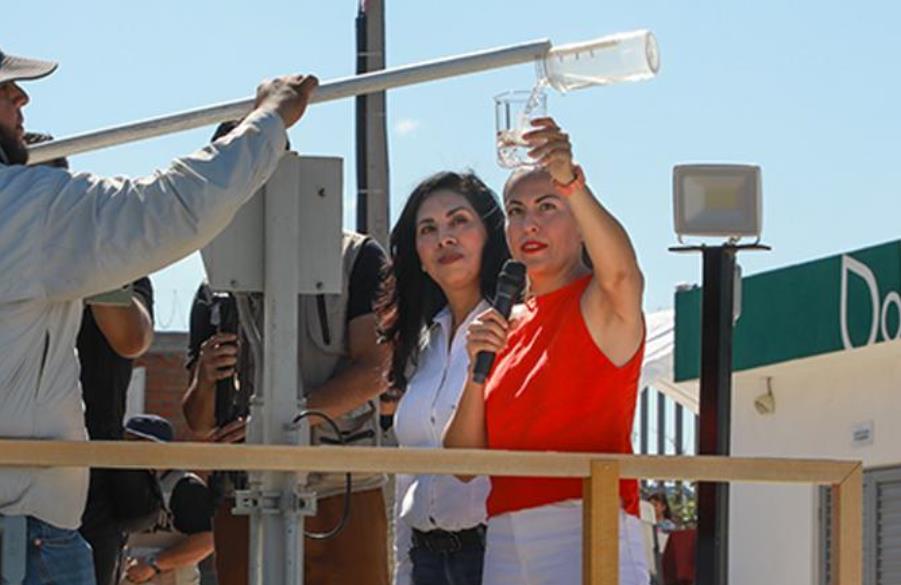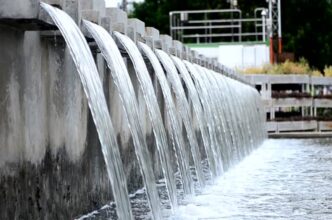The La Buena Mujer water treatment plant has begun distributing drinking water to the municipal network of La Paz after successfully completing quality tests confirming the potability of the supply from the dam of the same name. The project, part of the “More Water for La Paz” program, will add 70 liters per second to the city’s system operated by OOMSAPAS, the Municipal Water, Sewerage and Sanitation Agency.
During a press conference on Sunday, November 9, at the plant’s facilities, Mayor Milena Quiroga announced that water distribution began over the weekend following the completion of laboratory tests verifying its quality. The announcement comes after months of complaints from residents reporting low pressure and irregular service in various parts of the city.
The certification process, Quiroga explained, was carried out by OOMSAPAS’s internal laboratory, the State Commission for Protection Against Sanitary Risks (COEPRIS), and an independent certified laboratory in Mexico City.
“On Friday, November 8, we received the final test confirming that the water is of excellent quality, and we are now ready to supply it to the public,” said Quiroga. “Water from the La Buena Mujer dam has been entering the network since Saturday.” She added that the project would improve service in neighborhoods that have long faced rationing issues by integrating this new source into the existing distribution system.

The first phase will benefit neighborhoods including Márquez de León, Vista Hermosa, Villas de Guadalupe, Laguna Azul, Paredones, and Lagunitas. With the increased volume, the city aims to regulate service frequency and improve water pressure, especially in higher elevations.
Engineer Abigail Solano, Water Treatment Coordinator at OOMSAPAS La Paz, said the plant’s rehabilitation involved replacing filters and installing an activated carbon system to remove manganese, which previously affected water quality.
“The filter media were replaced with catalytic materials designed to remove manganese andactivated carbon filters were added to reinforce the process,” Solano explained. “Analyses by COEPRIS and a certified laboratory confirm that the water meets standards for human consumption.” She noted that OOMSAPAS will conduct continuous internal monitoring and certified analyses every three months, as required by Mexican health regulations.
OOMSAPAS Director Zulema Lazos said the plant’s operation represents a strategic step in the city’s comprehensive supply plan by strengthening distribution to northern and eastern neighborhoods.
“These efforts are part of the More Water for La Paz initiative, which aims to increase the city’s overall water availability,” Lazos said. “The treated water from this plant will not only benefit the connected neighborhoods directly but also allow redistribution to other areas, improving coverage across the municipality.”
Responding to questions about the dam’s capacity, Mayor Quiroga said the National Water Commission (Conagua) has authorized the extraction of 70 liters per second for three consecutive years, even without significant rainfall. She noted that the dam’s current water level of 349.15 meters above the crest allows for sustained operation.
The mayor also reported that the municipality operates a real-time measurement system to detect leaks or illegal connections within the network. Large-capacity meters at the pumping stations compare inflow and outflow volumes to ensure the treated water reaches the elevated tanks in full.
Quiroga emphasized that the City Council continues to coordinate with the Ministry of Environment and Natural Resources (Semarnat) and Conagua to ensure compliance with all technical and environmental requirements. She said the project’s improvements are part of a long-term plan to guarantee a stable and sustainable water supply.
The total investment in the La Buena Mujer plant amounts to 160 million pesos (approximately $8.7 million USD), with an additional 23 million pesos recently allocated for new filtration systems. The filtration materials, imported from Germany, are expected to last up to 10 years.
With the launch of the La Buena Mujer plant, La Paz gains an additional water source that will reduce dependence on the Carrizal aqueduct, improve system balance, and benefit more than 30,000 families across the municipality.




